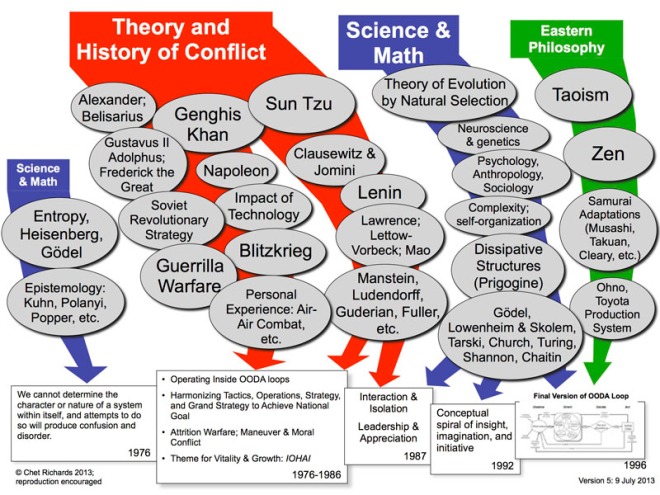Source Link


And when did he think it?
In his own words:
For the interested, a careful examination will reveal that the increasingly abstract discussion surfaces a process of reaching across many perspectives; pulling each and every one apart (analysis), all the while intuitively looking for those parts of the disassembled perspectives which naturally interconnect with one another to form a higher-order, more general elaboration (synthesis) of what is taking place. As a result, the process not only creates the Discourse but it also represents the key to evolve the tactics, strategies, goals, unifying themes, etc., that permit us to actively shape and adapt to the unfolding world we are a part of, live in, and feed upon. Abstract (c. 1987)
I took a stab at illustrating Boyd’s process:

The bubbles in the arrows show some of “perspectives” he pulled apart. The boxes along the bottom represent his syntheses, the presentations that make up his Discourse on Winning and Losing.
I was involved at the two ends, “Destruction and Creation” (1976) on the left and the two boxes — Conceptual Spiral (1992) and The Essence of Winning and Losing (1996) — on the far right.
It turns out that one of Boyd’s closest associates, Chuck Spinney, also drew a flow chart depicting how his concepts developed. Chuck was intimately involved with all the boxes on the chart:

This isn’t in strict chronological order (neither is mine), but in terms of how the ideas came to maturity, I agree completely.
Both of these illustrate the process of many-side, implicit cross-referencing across a variety of domains. The rest of Boyd’s concept of Orientation, “projection, empathy, correlation, and rejection,” usually involved phone calls late into the night. Coram’s book describes this very well.
Incidentally, Chuck noted that early on, “ODA” stood for “Orientation, Decision, Action” which John came up with during his time running Development Planning on the Air Staff at the Pentagon. Later, he added “Observation.”
All of the presentations and papers mentioned here, with the exception of the Aerial Attack Study and Boyd’s original Energy-Maneuverability (E-M) papers (which would be of interest only to historians of air-air combat and are summarized in New Conception) are available from the Articles page.
No comments:
Post a Comment